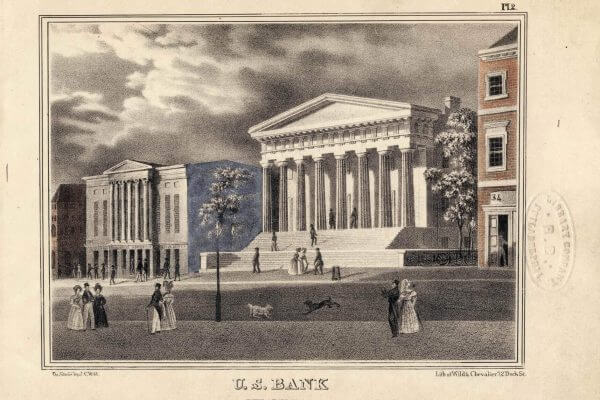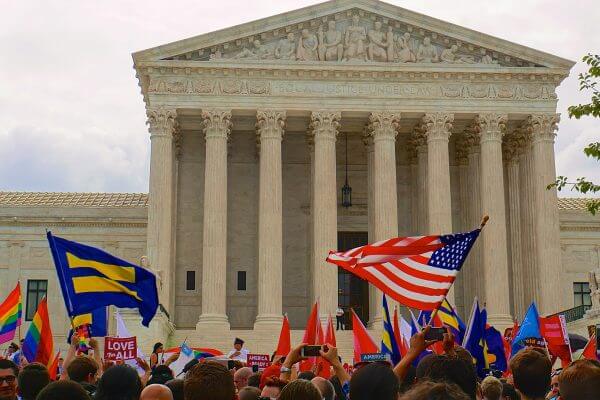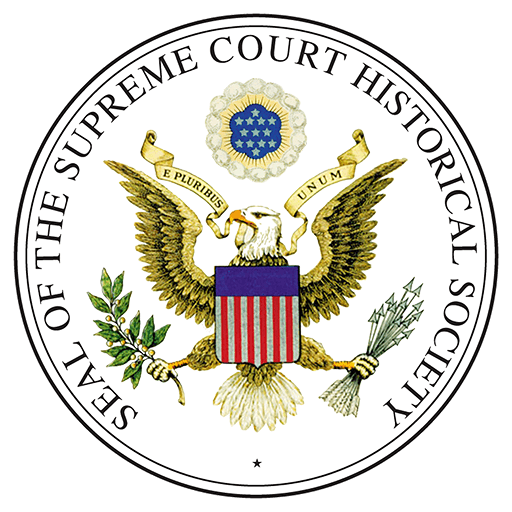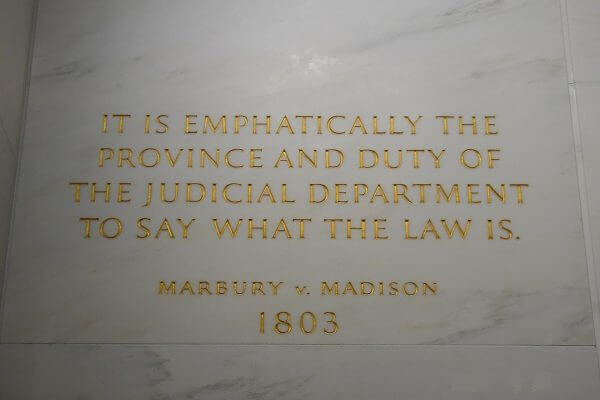
Marbury v. Madison (1803)
Establishment of Judicial Review and the Importance of the Separation of Powers
Marshall's famous line from Marbury v. Madison on American federal courts' power to interpret the law, now inscribed on the wall of the U.S. Supreme Court Building in Washington, D.C.
Photo Credit: User:NuclearWarfare, Public domain, via Wikimedia Commons
Overview
At the end of President John Adams’ term, his secretary of state failed to deliver documents commissioning William Marbury as justice of the peace in the District of Columbia. Once President Thomas Jefferson was sworn in, he told James Madison, his secretary of state, not to deliver the documents to Marbury and others in order to keep members of the opposing political party from taking office. Marbury sued James Madison asking the Supreme Court to issue a writ requiring him to deliver the documents necessary to officially make Marbury justice of the peace. The Supreme Court chose not to answer Marbury’s question, but rather whether they had the jurisdiction to issue the writ. The Marbury v. Madison decision resulted in the establishment of the concept of judicial review.
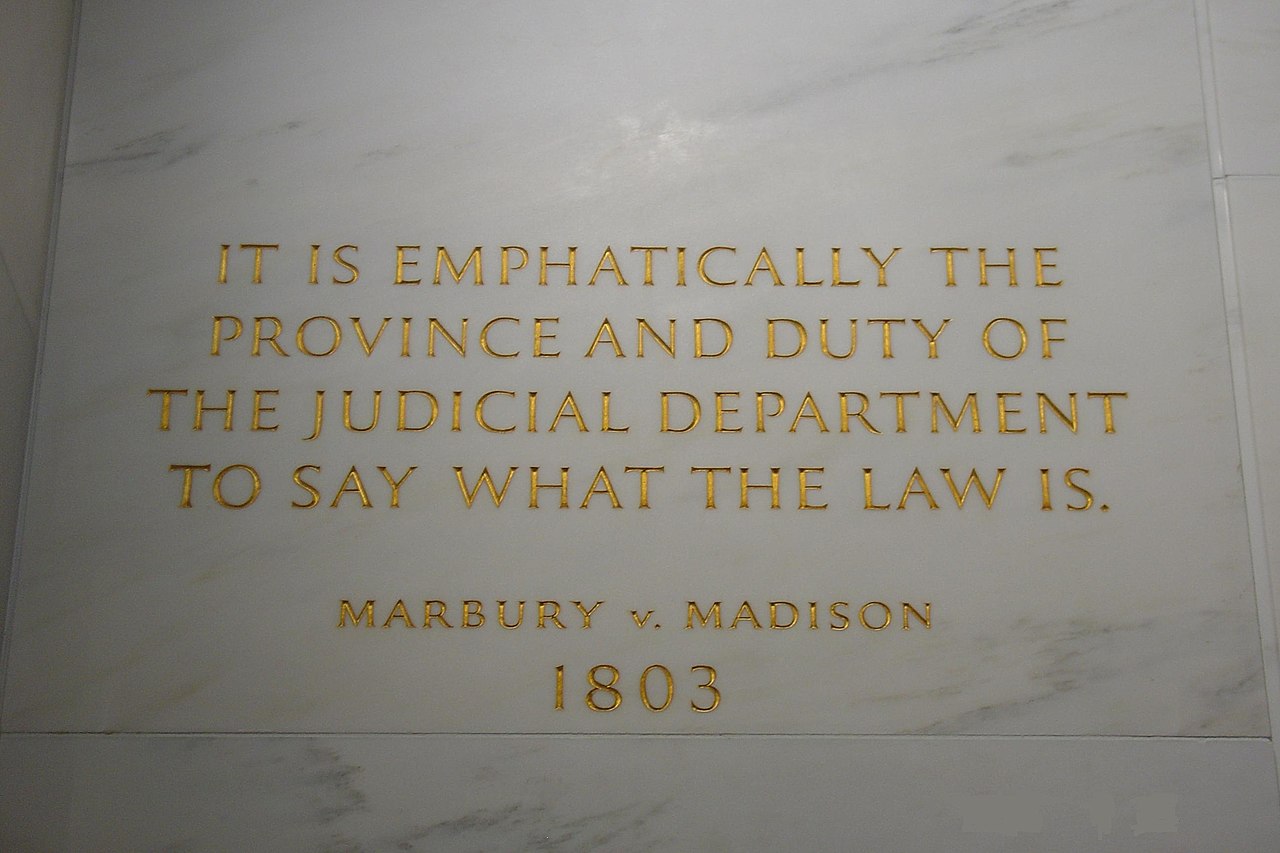
Marshall's famous line from Marbury v. Madison on American federal courts' power to interpret the law, now inscribed on the wall of the U.S. Supreme Court Building in Washington, D.C.
Photo Credit: User:NuclearWarfare, Public domain, via Wikimedia Commons
"It is emphatically the province and duty of the judicial department to say what the law is. Those who apply the rule to particular cases, must of necessity expound and interpret that rule. If two laws conflict with each other, the courts must decide on the operation of each."
- Chief Justice John Marshall, speaking for a unanimous Court
Learning About Marbury v. Madison
Students
This section is for students. Use the links below to download classroom-ready .PDFs of case resources and activities.
About the Case
Full Case Summaries
A thorough summary of case facts, issues, relevant constitutional provisions/statutes/precedents, arguments for each side, decision, and case impact.
Case Background and Vocabulary
Important background information and related vocabulary terms.
Learning Activities
Teachers
Use the links below to access:
- student versions of the activities in .PDF and Word formats
- how to differentiate and adapt the materials
- how to scaffold the activities
- how to extend the activities
- technology suggestions
- answers to select activities
(Learn more about Street Law's commitment and approach to a quality curriculum.)
About the Case
- Full Case Summaries: A summary of case facts, issues, relevant constitutional provisions/statutes/precedents, arguments for each side, decision, and impact. Available at high school and middle school levels.
- Case Background: Background information at three reading levels.
- Case Vocabulary: Important related vocabulary terms at two reading levels.
- Diagram of How the Case Moved Through the Court System
- Case Summary Graphic Organizer
- Case Summary Graphic Organizer - Fillable
- Decision: A summary of the decision and key excerpts from the opinion(s)
Learning Activities
After the Case
- Chief Justice John Marshall’s Legacy
- So, What’s the Big Idea???
- Mini-Moot Court Activity: United States v. Lopez (1995)
Teacher Resources
Teaching Strategies Used
Planning Time and Activities
If you have ONE day...
- Read the background summary (•••, ••, •) and answer the questions.
- Complete Who Should Decide? activity.
- Complete the Classifying Arguments Activity. Discuss which arguments the students find most convincing.
- For homework, have students read the Key Excerpts from the Unanimous Opinion and answer the questions. Follow up the next day by reviewing the questions with students.
If you have TWO days...
- Complete all activities listed for the first day (excluding homework).
- For advanced classes, complete The Power of the Judicial Branch. For on-level classes, complete Is the Judiciary Act of 1789 Constitutional?
- Complete the Cartoon Analysis Activity.
- For homework, have students read the Key Excerpts from the Majority Opinion and answer the questions. Follow up the next day by reviewing the questions with students.
If you have THREE days...
- Complete all activities listed for the first and second days.
- On the third day, have students predict how different individuals, such as Republicans, may have reacted to the outcome. Complete the Thomas Jefferson's Reaction Activity.
- Wrap up the discussion with So, What's the Big Idea???
- For homework, have students complete Chief Justice John Marshall’s Legacy project.
If you have FOUR days...
- Complete all activities listed for the first, second, and third days (excluding homework).
- On the fourth day, complete Mini-Moot Court Activity: United States v. Lopez (1995)
- For homework, have students complete Chief Justice John Marshall’s Legacy project.
Glossary
These are terms you will encounter during your study of Marbury v. Madison. View all Glossary terms here.
Related Cases
Legal Concepts
- These are legal concepts seen in Marbury v. Madison. Click a legal concept for an explanation and a list of other cases where it can be seen. View all Legal Concepts here.
